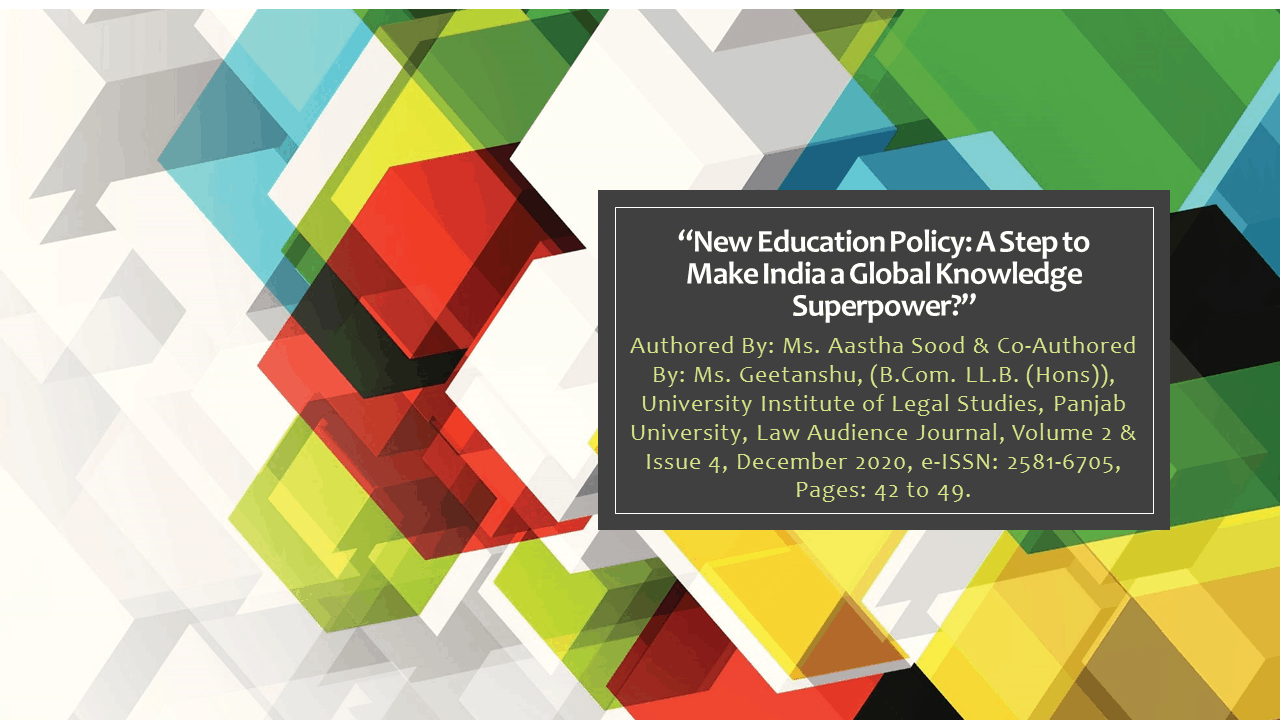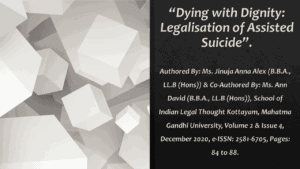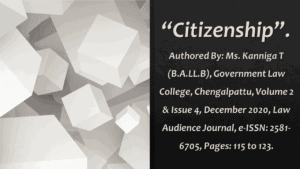Click here to download the full paper (PDF)
Authored By: Ms. Aastha Sood (B.Com. LL.B. (Hons)), & Co-Authored By: Ms. Geetanshu (B.Com. LL.B. (Hons)), University Institute of Legal Studies, Panjab University.
Click here for Copyright Policy.
Click here for Disclaimer.
“The only good is knowledge, and the only evil is ignorance” ~ Socrates.
I. KNOWLEDGE: THE BASIS OF EDUCATION:
If ignorance was a bliss then there is no point to work hard to be smart enough to survive among the fittest. Even the basic life questions would be left unanswered. Would it even make human existence possible? Such a situation would not even be mere existence as maintaining that status quo would also require practice and at least the knowledge of surroundings and so we can say that is not ignorance but knowledge is a bliss and what better way to attain knowledge than through education itself, without education survival among the fittest would not be possible. It was in Round Table Conference, 1931 that Babasaheb Ambedkar opined that everyone has a right to learn. Though education as a fundamental right was given explicit shape by the 86th Constitutional Amendment Act but the Hon’ble Supreme Court has always considered it as an intrinsic part under the right to life. It was education that brought us to the 4th Industrial Revolution, it will be this education that will take us to the next one and many more to come.
II. INDIA’S RICH ANCIENT EDUCATION SYSTEM:
As our young nation strive towards development and advancing our capabilities globally, it becomes imperative to go through the schools of history and understand that India had an education system that was historically designed, socially inclusive and outcome-oriented. Be it Lopamudra or Indrani, the ancient Indian education system was never discriminative against the fairer gender and it was neither about all cramming. Vocational training, professional studies and various courses with research and development were given special importance. But the British Raj delegitimised the Indian education system. After Macaulay’s Minutes of 1835, the colonial government’s work in education was primarily motivated by self-serving concerns. The spread of western education led to the scientific, technical or moral education being ignored to level that it was safe to assume that Indians had been left far behind the modern structures of knowledge and their ancient wisdom presumably stripped off and caged in scriptures. Colonialization did its part in destroying Indian systems of education. Mahatma Gandhi was correct in saying that the beautiful tree of education in India was cut by British making India far more illiterate than it was 100 years ago.
III. FACTS AND FIGURES:
Change is the only constant and there is a great need for something new and fresh that can keep the society up with the pace of advancement that the modern world is looking at. Today the challenges that educationists face are multi-pronged. The figures revealed by ASER, 2019 (Annual Survey of Education Report) is a matter to agonise, with only 16% of children in the age group of 4 to 8 years are able to read text at that prescribed level. Data by census 2011 state that female literacy rate is almost 20% less than the male literacy rate.
The average literacy rate among Scheduled Castes is 9% and among Scheduled Tribes being 17.4% reflect how badly we need social inclusion in the education system. Apart from this, there is no equity in the gross enrolment ratio with it being 26% for the general category and 16% in case of Scheduled Tribes. Where on one hand Telangana has 59 colleges for its population, Bihar has only 7 colleges for the same level of eligible population. There is a need to closely supervise and monitor the existing inept education system. No doubt the New Education Policy 2020 as recommended by T.R.S Subramaniyam Report is a much-needed guiding light but a lot of ground needs to be covered.
IV. THE EARLY INITIATIVES:
The answer to India’s problems actually lies in schemes like EQUIP (Education Quality Upgradation and Inclusion Programme) which aims to double the Gross Enrolment Ratio in higher education and remove social and regional disparity. Apart from comprehensive educational work, India being a member of Shanghai Corporation Organisation (SCO) noted the importance of spiritual and moral education to counter attempts to involve youth in activities of terrorism, separatism and extremism. In India, social inclusions are an important factor for improving the education system. The SAMAGRA SHIKSHA scheme is a right step towards this direction, this scheme not only focuses on enhanced funding on education but also focuses on the quality of education. Its commitment to “Sabko Siksha, Achhi Siksha” is what will make Indian education actually inclusive and developed.
V. NEP: PRIMARY AND SECONDARY EDUCATION:
After a staggering period of 34 years, the federal government of India infused some relief from the old, outdated and seemingly faulty education system of rote learning that focused on marks and was mixed with abundant hardships for the students leaving them underprepared for the real world by introducing the New Education Policy on July 29, 2020. The policy with its main focus on “learning how to learn” and aims at universal provision of education and achieving global standards for education at all levels. Where on one hand it has been called “revolutionary” and as “education for the 21st century”, on the other hand it can also be scrutinised and dissected to surface its flaws. The changes laid out in the NEP mirror the educational models of some of the most powerful and developed countries in the world, like it has focused on the use of mother tongue or local language as a medium of instruction till Class 5 and its continuance till class 8th (wherever possible) and proposes that reading and writing skills in other languages to be taught in class 3 and beyond.
This model has been in practice in countries like Europe and though there is no doubt that it will help the child learn and understand better and even more quickly which will obviously bore fruit in his later stages of life, however, what needs to be seen is that in a country like India where our countrymen still identify certain languages with privilege, this change can further widen the class-based inequality as it is a matter of fact that it becomes difficult to pick up languages as one grows older, also this can act as an added burden on the children who already have much on their plate by now and this will further have implications on the progress of children of certain regions in terms of accessibility to higher education in other countries and employment. Another change that the policy proposes is a 3 language formula- wherein both private and public schools have the option of studying 3 languages at the school level, the autonomy of deciding such languages is with the states but out of which at least 2 must be native. Where on the face of it, it is no doubt that this move gives equal opportunity to the states for the promotion of their neglected regional languages and the betterment of the minorities who till now were deprived of education due to unfamiliarity with the other languages. However, some states, especially Tamil Nadu with its existing 2 language policy feel that this move is an attempted imposition of Hindi and Sanskrit and promoting it seems less for the child’s development and more for the satisfaction of the politicians’ ego.
Another important change introduced by NEP is that the present 10+2 system pedagogy prevalent in the country for over 50 years has been changed to 5+3+3+4 design that is 5 years of foundational stage (3 years of pre-primary and Grades 1 and 2), 3 years of foundation i.e., latter primary (Grades 3, 4 and 5), 3 years of middle i.e., upper primary (Grades 6,7 and 8) and 4 years of high/secondary stage (Grade 9,10,11 and 12). The inclusion of pre-primary in the formal education is more than a welcome change and this will bring the hitherto uncovered age group of 3-6 years under the school curriculum which has been recognised globally as the crucial stage for development of mental faculties of a child.
However, a key concern here is that a large proportion of children in this age group receive their schooling from Anganwadi, whose workers are already demanding better recognition, wages and work conditions among other things. Though NEP proposes to give such workers an online training of 6 months to make them at par with formal education system but this will only result in additional responsibility with no recognition and none of their demands being met.
This change thus brings along with it a stronger need to provide these workers with better wages, standard of living and recognition so that they can handle these additional responsibilities and contribute to their full potential. Along with all this, NEP also aims to change the current assessment system with its aim to reduce pressure upon the students by reducing the difficulty of board exams and allowing students to retake exams if they feel the need to improve.
The system also aims to reduce curriculum content (which is fondly called the syllabus) to enhance essential learning and critical thinking, by including space for more holistic, experimental, discussion and analysis-based learning. Probably the most important change in the pedagogical structure is the fact that there is going to be an effort to avail the students to study across arts, humanities, sciences, sports and vocational subjects. A softer separation of subjects is to be promoted, especially that of arts and science subjects[1].
VI. NEP: HIGHER EDUCATION:
The creators of the policy seem to have realised the fact that while primary education builds the base of the student, higher education focuses on the structure and thus both have to go hand in hand, hence the NEP has also tried to revolutionise the higher education. Its aim is to completely overhaul the present system and thereby re-energising higher education as multidisciplinary. NEP proposes the phasing out of all institutions offering single streams and all universities and colleges must aim at becoming multidisciplinary by 2040. The NEP is focussed on increasing the Gross Enrolment Ratio in higher education space which is currently around 26%. The document states universities from among the top 100 in the world will be able to set up campuses in India.[2] This move comes as a relief to the various students who go abroad for their further studies, it has been noted that approximately 1 lakh Indian international students were enrolled in degree programmes abroad in the year 2004 and this number nearly doubled in the year 2017.
So as much as interesting and promising this move seems, one cannot help but think that how many of such universities would be interested in such an opportunity. The Indian Express, in a study conducted in 2013 had reported that the top 20 global universities, including Yale, Cambridge, MIT and Stanford, University of Edinburgh and Bristol, had shown no interest in entering the Indian market. Also, there is an imperative need for a legislative enactment regarding the details of the operation of foreign universities in the country which caters to each and every aspect including the present system of reservation, exchange programmes to name a few. Interestingly enough a similar bill Foreign Educational Institutions (Regulation of Entry and Operations) Bill, 2010, was proposed in 2010 which eventually lapsed. Another feature is that the NEP also offers flexibility to institutions to offer different designs for masters program which will lead to a renewed focus on every field and this form of education will help the students grow holistically. The NEP also proposes to discontinue the present M-Phil program and also there will be an academic bank of credits (ABC) for students opting for sabbatical of 1 year. Further, a four-year programme is proposed where the students can exit after one year with a certificate, after two years with a diploma, and after three years with a bachelor’s degree.[3]
Funnily enough, this is the same program which the Delhi University was forced to scrap at the behest of the government. Some eminent scholars believe that this approach will increase the rate of dropouts, the opposite of what is aimed. Another important aim of this policy is to phase out the system of affiliation in the coming 15 years and grant autonomy to colleges. However, one cannot help but fear that this may ultimately lead to privatisation of education leading to denial of social justice. A national Higher Education Regulatory Body is also intended to be set up as a single point regulator except for the fields of law and medicine which ultimately implies the abolition of UGC, AICTE and NCTE. In order to facilitate and normalise research, NEP proposes to set up a National Research Foundation to grant funding to outstanding research proposals across all disciplines.
VII. NEP: TUTORS:
The success of the newly introduced changes can come into practice with professionally trained, passionate and highly qualified teachers and the sad fact is that these basic skills are not found in most education providers today; the reasons being privatised teacher education institutions which provide degrees on payment of a price, lack of initiatives to recruit the best teachers, severe shortcomings and suboptimal practices in the deployment of teachers and defected teachers training program. Further the low standard of living, unrecognised status and meagre salary structure ultimate lead to disinterested and demotivated teachers. The NEP comes as a ray of hope to subvert these problems by introducing measures like special merit-scholarships with guaranteed employment, incentives to take up jobs in rural areas, decreased number of teacher transfers, and proposing to increase the public investment in education sector to 6%.
VIII. NEW EDUCATION POLICY: GLIMMER OF HOPE?
This initiative feels to be both visionary and ambitious[4]. No doubt it does have several strengths but it also carries along with it several ambiguities and loose ends that are confusing and leaves one to question the success of this policy. It aims to increase the government funding on education from the current 4.6% of its total GDP to 6% at the earliest but it does not highlight how the centre would raise this fund amidst an ongoing economic crisis and also education being a matter of the concurrent list, it is always a question of debate as to who exactly will bear the burden of this expenditure- the centre or the state?
Also, there has been no clarifications made on the 2% cess for education introduced in the year 2004 by the centre- will that cess be a part of the primary budget or will it be an additional tax as conceptualised in the beginning?
History is a witness that it takes years for plans and policies to turn into action, just like only 10% of the schools are meeting the RTE norms even after even after 11 years of enactment of Right to Education Act, 2009, the New Education Policy 2020 with its unclear road map may take even more years for its successful implementation. This execution may further be hampered due to the lack of financial resources which has always been a concern for the successful realisation of policies in India. Corruption in the education sector may prove to be another stumbling block in the success of NEP because privatisation of education under this policy will add to this misfeasance.
IX. THE NEED OF CUMULATIVE EFFORTS:
In the humble opinion of the authors, the future of a nation is based upon the education it delivers to its young minds. For our country to reach its zenith, a comprehensive and robust education system is called for. This system must be a blend of modern initiatives and principles of ancient wisdom. The transitions from a mediocre academic score to the world’s finest education system would require spending more finance on education along with ideal steps in the right direction. India’s policies and initiatives have always been a success on paper but the main concern is their lewd implementation which results in all efforts being thrown down the drain.
If implemented in its true vision, this new structurer can bring India at par with the leading countries of the world. It is now the collective responsibility of each and every native of this nation to make this visionary and holistic policy a success.
[1] NATIONAL EDUCATION POLICY:2020: CRITICAL ANALYSIS OD KEY POINTS https://www.clawlegal.org/editorial/national-
education-policy-2020-critical-analysis-of-key-points/#_ftn2 retrieved on 24th November 2020.
[2] https://indianexpress.com/article/explained/reading-new-education-policy-india-schools-colleges-6531603/ retrieved on 26th November 2020.
[3] Ibid.
[4] https://www.highereducationdigest.com/new-education-policy-a-few-important-things-that-you-need-to-know-from-the-leaders-in-education/ retrieved on 25th November 2020.



